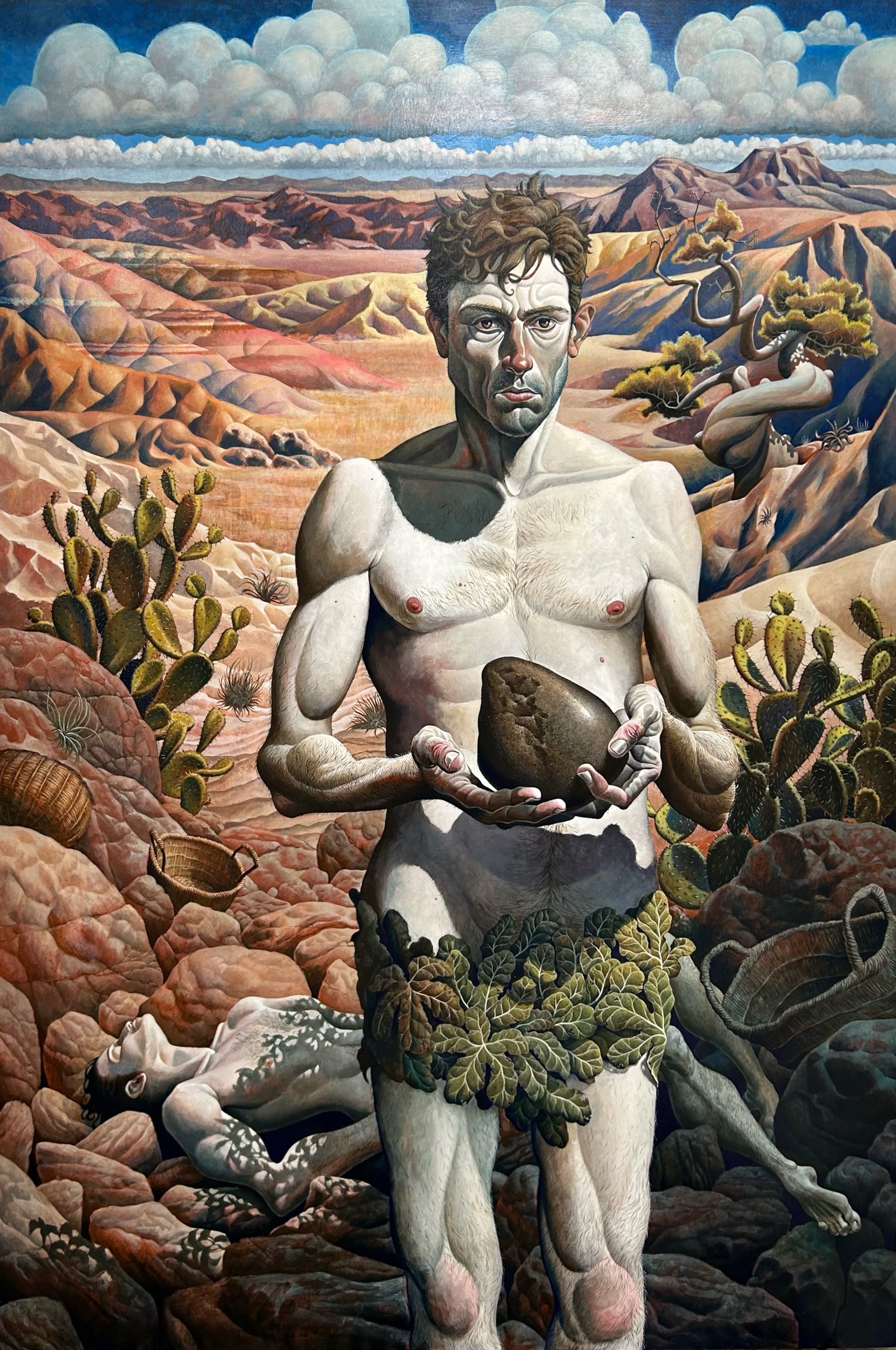
Cain, 2024, 48 x 72
“Cain” – Acrylic Painting by J. Richard Briggs
Mythical Realism | Biblical Narrative Art | Shame, Exile, and the Burden of Grief
“Cain” by J. Richard Briggs is a striking acrylic painting that reinterprets the Genesis narrative through the lens of Mythical Realism, exploring the raw interiority of a man marked not just by guilt, but by shame, abandonment, and disoriented longing. This is not the villainous Cain of flattened moralism, but a figure standing in the brutal clarity of exile—haunted, exposed, and stripped bare beneath the weight of divine silence.
Set in a desolate, scorching landscape, the figure of Cain emerges from a palette of fractured terrain and coiled grief. His gaze pierces outward—hollowed, angry, and stunned—as he clutches the stone of his brother’s death with both hands. His body is lean, pale, cracked with dryness and hunger; his fig leaf garment feels more ritual than covering, signaling a fractured dignity rather than innocence lost.
Behind him lies the body of Abel, swallowed by the very earth that received his blood. His form is dappled in light and shadow—suggesting both divine favor and tragic finality—while baskets, symbols of offering and provision, lie scattered and overturned across the rocks. The landscape is littered with symbols of effort and futility, presence and absence.
Briggs offers a theological and psychological portrait of Cain as a figure suspended between divine judgment and human longing—a man not damned, but wandering, misunderstood, and bearing more than his soul can carry. The painting invites reflection on shame that outlives the act, the ache for reconciliation that never comes, and the silent burden of being seen but not restored.
Through richly textured acrylics and careful symbolic detail, Cain reclaims this ancient figure not as a warning, but as a mirror: one who lives beneath the same sky, bearing the marks of failure, sorrow, and a desperate hope for grace.


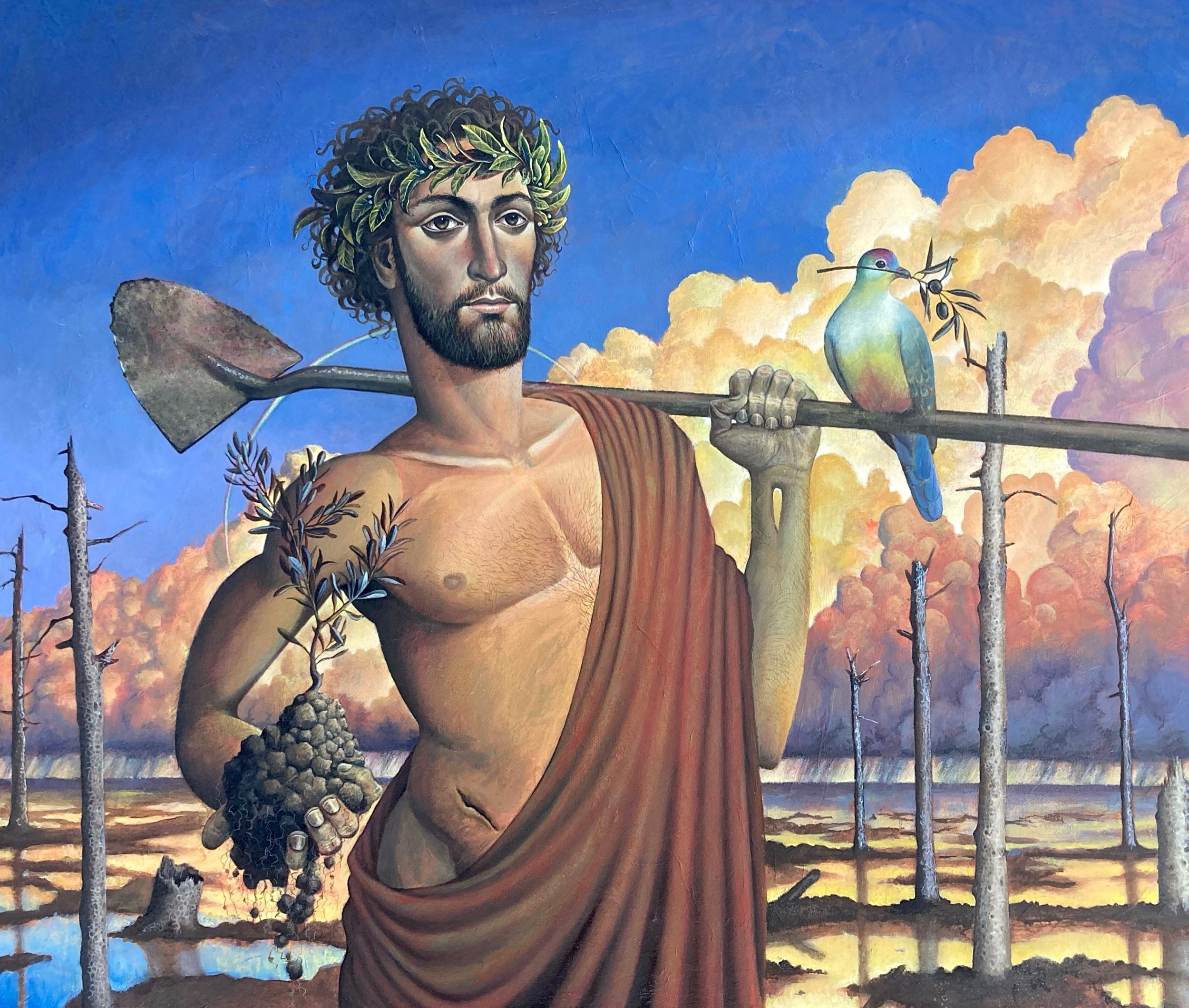
The Gardener, 2021, 20 x 24
“The Gardener” – Oil Painting by J. Richard Briggs
Mythical Realism | Contemporary Religious Symbolism | Post-Apocalyptic Hope
“The Gardener” by J. Richard Briggs is a powerful and symbolic oil painting that weaves together themes of creation, resurrection, ecological grief, and sacred labor. Painted in Briggs’ signature Mythical Realism style, the piece presents a solitary figure—part Adam, part Christ, part eternal archetype—standing barefoot in a ravaged landscape.
Clutching a clump of soil with a rooted olive shoot in one hand and balancing a shovel across his shoulders in the other, the Gardener becomes a living icon of restoration. A dove bearing an olive branch perches calmly beside him, echoing Noah’s flood narrative and offering a fragile but persistent image of peace. Around him, a scorched and flooded wasteland stretches out, punctuated by dead trees and brooding, apocalyptic skies—yet the figure remains steady, grounded, resolute.
Briggs’ use of oil paint heightens the emotional and textural depth, allowing light to move richly across skin, metal, soil, and sky. The painting draws from Byzantine iconography, scriptural motifs, and ecological allegory, capturing the tension between devastation and hope, destruction and rebirth.
This work invites viewers into a theological and existential reflection on humanity’s role as both destroyer and cultivator—those tasked with the sacred, often forgotten work of tending what has been broken.
Ideal for collectors of spiritually resonant oil paintings, religious symbolism in contemporary art, or those drawn to climate-themed visual narratives, The Gardener stands as a mythic meditation on restoration, responsibility, and resilient hope.



Ecce Homo, 30 x 40, Oil on Canvas
Mythical Realism | Contemporary Sacred Art | Narrative Figurative Painting
This striking work by Pacific Northwest artist J. Richard Briggs reimagines the biblical story of Jesus asleep in the storm with emotionally charged figures, symbolic detail, and his signature Mythical Realism style. Painted in acrylic, this contemporary sacred artwork bridges the gap between traditional Christian iconography and modern psychological insight, portraying the disciples’ terror with raw physicality and expressive distortion, while Jesus remains mysteriously at peace—curled amidst rope like a radiant halo.
Briggs invites the viewer into the liminal space between panic and peace, chaos and trust, confronting themes of faith, anxiety, embodiment, and vulnerability. The composition’s surreal tilt, swirling waves, and intense facial expressions create a visceral tension that underscores the emotional and theological complexity of the scene.
Rich in religious symbolism and artistic depth, this painting reflects Briggs’ broader vision: to restore enchantment and spiritual resonance to contemporary figurative art. Influenced by Byzantine iconography, Jewish storytelling, and sacred visual tradition, his work reinterprets familiar biblical narratives through a modern, mythic lens.
Ideal for collectors of contemporary Christian art, spiritual figurative painting, or symbolic narrative art, “Jesus Asleep in the Boat” is both a visual meditation and a bold theological reflection—offering viewers not just an image, but an encounter.


The Eunuch, 2020, 20 x 24
“The Eunuch” – Oil Painting by J. Richard Briggs
Mythical Realism | Contemporary Sacred Art | Isaiah’s Prophetic Vision
“The Eunuch” by J. Richard Briggs is a contemplative and powerful oil painting inspired by the promise found in Isaiah 56, where the eunuch—historically excluded and rendered fruitless—is given by God “a name better than sons or daughters.” In this work, Briggs gives visual form to that radical inclusion, presenting a figure full of quiet strength, vulnerability, and sacred dignity.
The central figure stands bare in a barren field beneath a roiling violet sky, holding a worn scroll that displays a symbolic tree—half in bloom, half bare—rooted above a cluster of pomegranates. These ancient fruits, long associated with fertility, abundance, and sacred renewal, suggest a deeper spiritual legacy beyond traditional lineage. In his other hand, the eunuch holds a brush, poised not just as an artist but as a witness and a builder of meaning—someone called to participate in divine creativity.
Empty baskets surround him. Whether awaiting harvest or standing as symbols of past labor, they mark the tension between longing and fulfillment, between the silence of exile and the hope of restoration. The landscape echoes the emotional terrain of the piece—arid, unsettled, but not without promise.
Painted in oil with Briggs’ signature Mythical Realism, this work fuses ancient scripture with rich symbolism and psychological presence. It is both a theological meditation and an act of imaginative reclamation, drawing the viewer into a vision of hope, dignity, and spiritual fruitfulness in places long thought barren.
Ideal for collectors of spiritually engaged contemporary art, biblical narrative painting, or those drawn to symbolic figuration and sacred storytelling, The Eunuch stands as a visual testament to the enduring power of grace and divine invitation

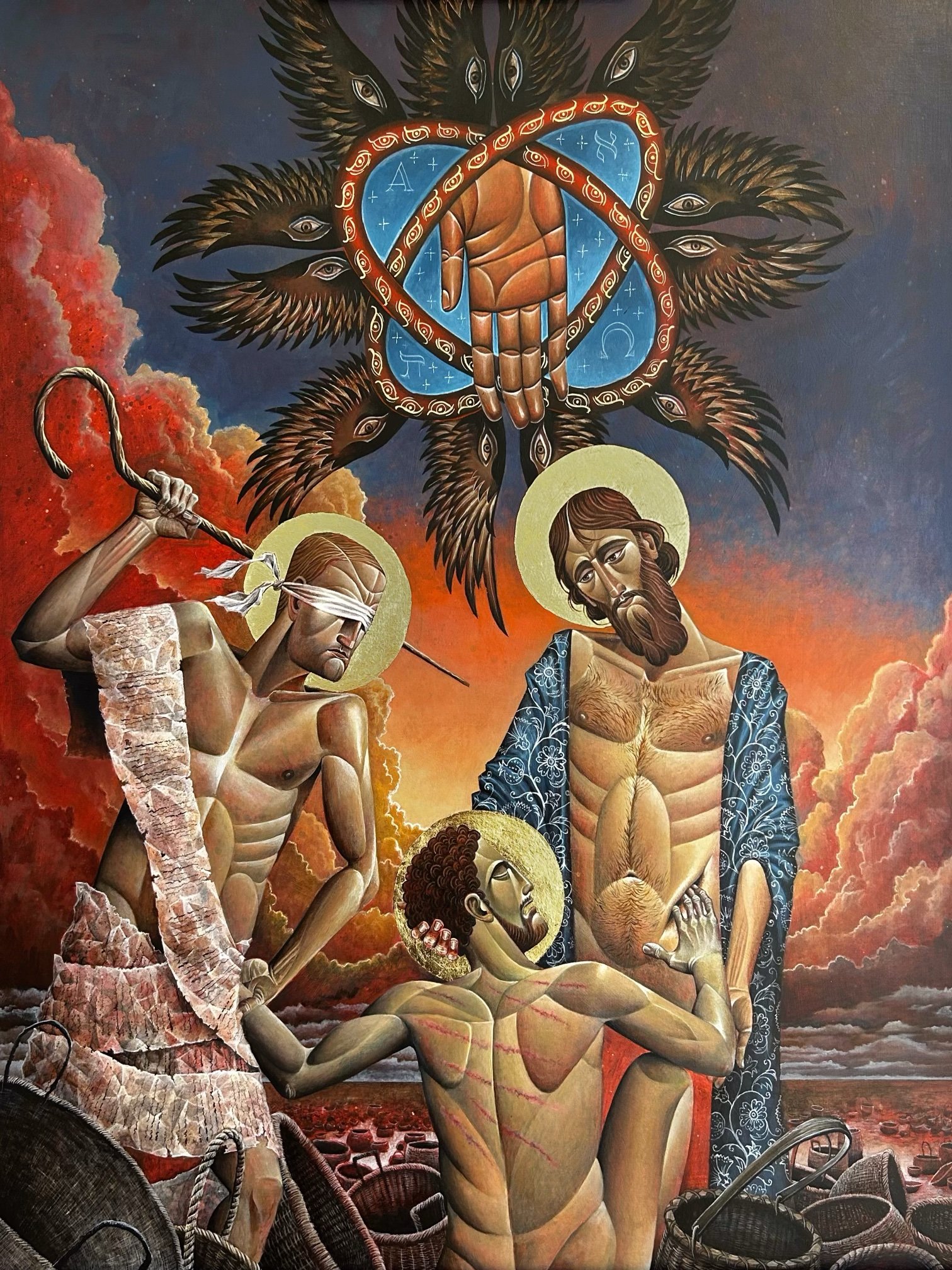
The Revelation of St. Thomas, 2023, 20 x 24
“The Incredulity of St. Thomas” – Acrylic Painting by J. Richard Briggs
Mythical Realism | Contemporary Iconography | Scripture, Doubt, and Sacred Wounding
“The Incredulity of St. Thomas” by J. Richard Briggs is a richly layered acrylic painting that reimagines the biblical moment of Thomas encountering the risen Christ—not as a tidy resolution of doubt, but as a charged meditation on faith, wounding, and the ways sacred authority can be misused.
At the center, Thomas, marked by fresh lash wounds, reaches toward the side of Christ with a mix of reverence and desperation. A halo encircles his head, affirming sanctity even in the midst of struggle. Christ stands beside him, tender and unflinching, exposing his own wounds—the site of invitation and belief. His body, vulnerable and glorified, bears the full weight of crucifixion, while a blue robe patterned with sacred motifs drapes around him like priestly vestment.
To the left, a shepherd figure, blindfolded and clothed in a scroll representing the scriptures, lifts a shepherd’s crook to strike Thomas. This shepherd is no gentle guide, but a pointed allusion to the corrupt shepherds of Ezekiel 34—those who exploit the flock in the name of God. Here, scripture is rendered as both garment and weapon: a sobering commentary on how holy texts are often used to justify harm, especially against the wounded and questioning.
Above the scene hovers a celestial vision—the hand of God surrounded by seraphic wings, eyes, and sacred symbols—echoing ancient iconography and apocalyptic imagery. This divine presence reminds viewers of the God who sees, who holds space for doubt, and who stands in solidarity with the wounded.
Rendered in acrylic with meticulous detail and emotional weight, this work is a vivid example of Briggs’ Mythical Realism—fusing traditional sacred art with urgent, modern questions. The Incredulity of St. Thomas becomes not just a depiction of a biblical episode, but a call to wrestle with the tension between belief and violence, tradition and truth, vulnerability and redemption.
Ideal for collectors of contemporary religious art, symbolic narrative painting, or those engaging with themes of spiritual abuse, justice, and the healing power of Christ, this piece invites reflection, confrontation, and ultimately, compassion.

“David Weeps Jonathan” 2020
“David and Jonathan” – Acrylic and Oil Painting by J. Richard Briggs
Mythical Realism | Biblical Narrative Art | Sacred Friendship and Grief
“David and Jonathan” by J. Richard Briggs is a deeply moving acrylic and oil painting that reimagines one of Scripture’s most intimate and tragic relationships. Drawing from the biblical account in 1 Samuel, this piece captures David cradling the lifeless body of Jonathan, pierced by an arrow, against the backdrop of a burning forest—a world unraveling in grief, love, and divine heartbreak.
Executed in Briggs’ signature Mythical Realism, the painting merges iconographic formality with emotional rawness, portraying David not as warrior or king, but as a broken-hearted mourner, his face lifted in anguish as fire consumes the trees behind him. Jonathan’s lifeless body is rendered in dark armor, arms limp, blood flowing—held with reverence by the man who once called him “more wonderful to me than the love of women.”
The figures are wrapped in flowing, patterned textiles reminiscent of sacred vestments, suggesting a kind of liturgy of loss. The cracked, vein-like textures across the surface resemble ancient frescoes, adding a layer of timelessness to the scene. The interplay of oil and acrylic enhances the tension between warmth and coolness, solidity and fragility, fire and stillness.
Briggs offers not just a biblical depiction but a visual meditation on grief, covenantal love, and the devastation of war. This is sacred lamentation—an image that invites viewers to dwell in the mystery of divine love expressed through human vulnerability, loyalty, and loss.
Ideal for collectors of contemporary biblical art, spiritually evocative figurative painting, or those drawn to narratives of friendship, devotion, and holy grief, David and Jonathan is a haunting and beautiful tribute to a bond forged in love and fractured by death.


That They May Be One, 2019, 36 x 48
Mythical Realism | Contemporary Sacred Art | Christ, Reconciliation, and the Grief of Division
“That They May Be One” by J. Richard Briggs is a profound and emotionally raw acrylic and gold leaf painting, offering a sacred meditation on Christ’s presence in the grief of relational rupture and societal polarization. Drawing from Jesus’ prayer in John 17, the painting visually embodies both the agony of division and the hope of reconciliation—not through triumphalism, but through tenderness, exposure, and sacred wounding.
At the center, the risen Christ, haloed and winged, bends over a vulnerable, bare figure, cradling his head with heartbreaking gentleness. If you look closely, you’ll see the gold-leafed scars in Christ’s wrists and side—subtle but unmistakable signs of resurrection through suffering. Christ is not elevated or distant, but intimately present in the dust and devastation, offering consolation to a body limp with grief and fragmentation.
Two other figures turn away in mirrored postures of sorrow or estrangement, echoing the ache of disunity that ripples through families, communities, and spiritual lives. Overhead, a banner in Hebrew from Psalm 133 reads, “Behold, how good and pleasant it is…”—a liturgical longing for unity that hangs above a fractured reality.
The painting is set against a rich, floral tapestry background that evokes sacred tradition—Byzantine iconography, illuminated manuscripts, and medieval altar panels—but Briggs infuses it with an urgent, contemporary ache. The result is Mythical Realism with theological teeth: symbolic, embodied, and alive with the tension between what is and what ought to be.
Ideal for collectors of resurrection-themed art, visual theology, and works exploring embodiment, reconciliation, and divine presence in suffering, That They May Be One is both a lament and a liturgy—a cry for healing in a world aching to be made whole.
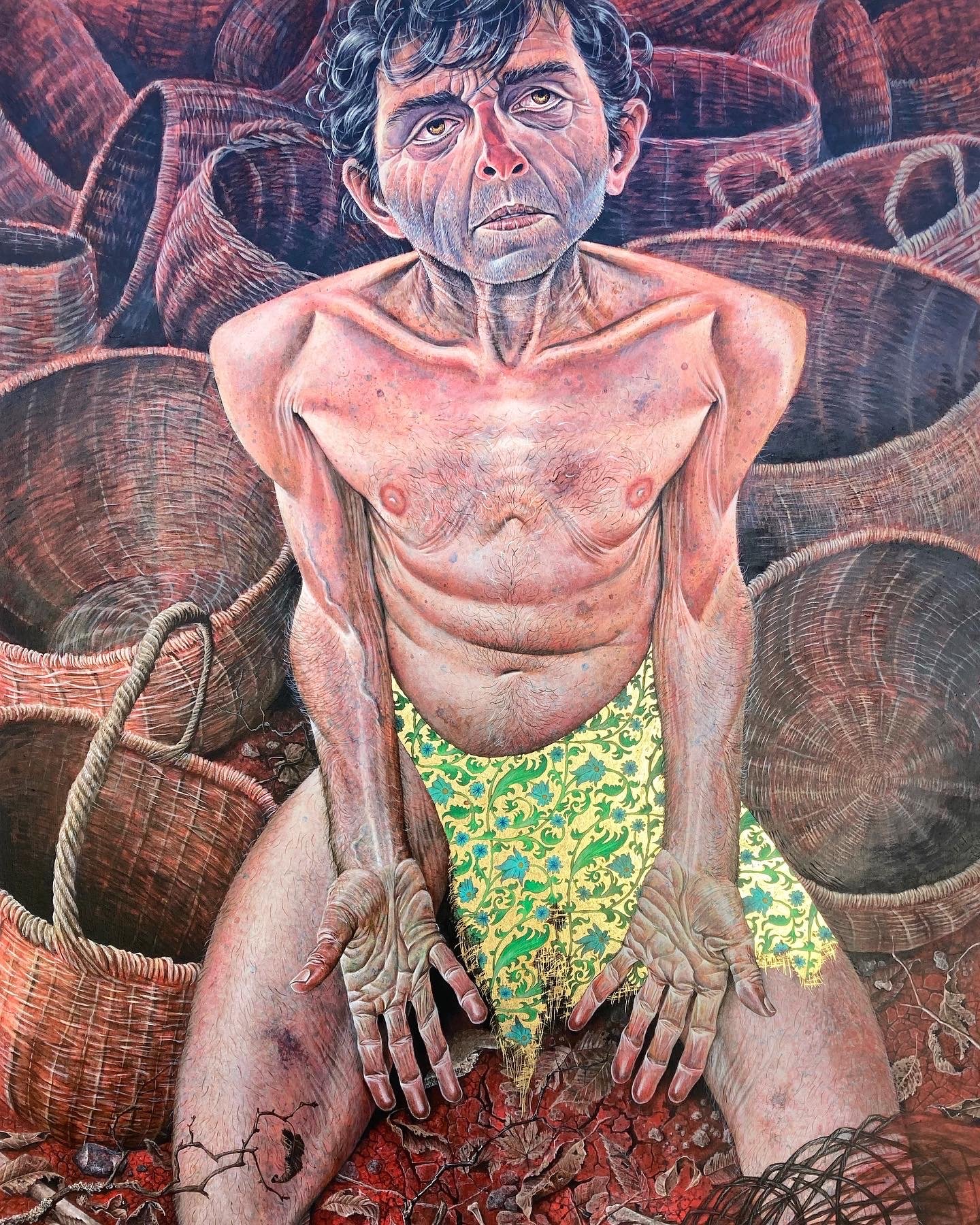
Job (After Karl Zerbe’s ‘Job’) 2023, 30 x 40
Mythical Realism | Contemporary Religious Art | Lamentation and Human Suffering
“Job” by J. Richard Briggs is a visceral and vulnerable acrylic painting that draws direct inspiration from Karl Zerbe’s mid-century depiction of Job, while reinterpreting the biblical sufferer through Briggs’ own lens of Mythical Realism. Stripped bare, seated among emptied baskets, and clothed only in a tattered cloth of ornate gold patterning, this Job is not a distant symbol—but a man with cracked hands, weathered skin, and eyes that have seen too much.
He sits hunched on scorched earth, surrounded by vessels of provision that are now empty—symbols of a life once full, now hollowed by loss. His open hands stretch forward in silent protest or unanswered prayer, capturing the raw ache of suffering without explanation, and the spiritual disorientation of divine silence.
Briggs’ use of acrylic brings an intense richness to the flesh tones, textures, and decaying beauty of the scene. The contrast between the lush, regal textile and the bruised, broken body beneath it underscores Job’s dignity even in desolation—a man crowned with sorrow, still upright in his ruin.
This painting is a meditation on lament, embodiment, and the endurance of faith in the absence of resolution. Echoing Zerbe’s emotional intensity but layered with Briggs’ own symbolic vocabulary, Job becomes a universal figure: wounded, bewildered, still asking to be seen.
Ideal for collectors of contemporary biblical art, existential religious painting, or those drawn to theology through human form, this piece invites viewers to sit in the ash heap and feel the gravity of unanswered suffering, sacred dignity, and the slow burn of hope.
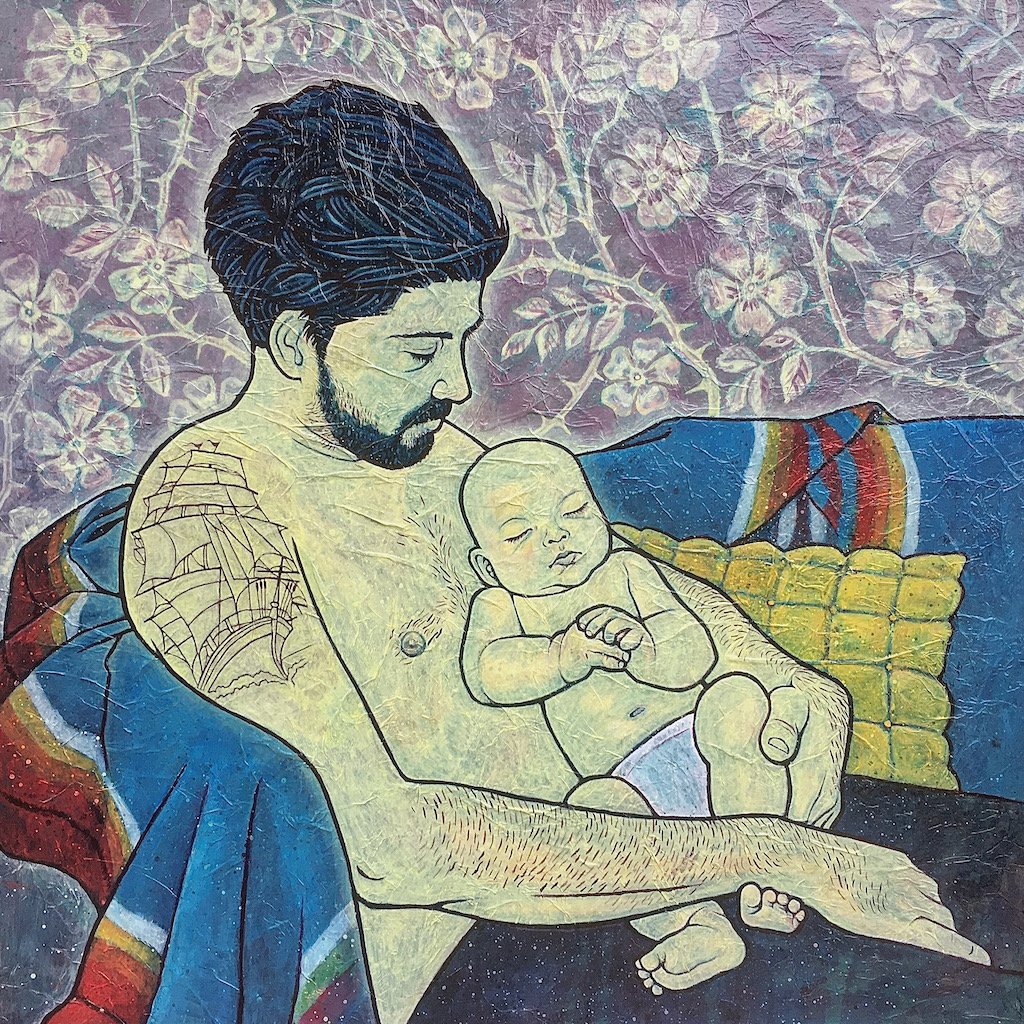
Madonna and Child (Reimagined), 2019, 24 x 24
“Madonna and Child (Reimagined)” by J. Richard Briggs is a gentle, luminous acrylic painting that reinterprets the ancient iconography of Mary and the infant Christ through the image of a modern father and his sleeping child. Infused with quiet reverence and vulnerability, the work offers a fresh vision of masculinity as nurturing, tender, and present—a sacred act of holding.
Wrapped in a striped wool blanket, the tattooed father cradles his baby with soft, protective arms. His gaze is downward, absorbed in the miracle of proximity, his body curved around the child like a halo of warmth. Behind them, a field of pale florals emerges across a textured lavender backdrop, echoing the visual tradition of sacred portraiture and drawing on Briggs’ signature Mythical Realism—where domestic moments are transfigured into spiritual events.
The intimacy of the scene reclaims and re-centers fatherhood as a holy vocation, suggesting that tenderness, quiet strength, and care are not counterpoints to masculinity—but essential to it. It is an image that holds both contemporary resonance and ancient symbolism, reminding viewers that the sacred doesn’t always arrive in cathedrals—it arrives in couches, cradles, and everyday acts of love.
Ideal for collectors of modern sacred art, symbolic portraiture, and art exploring masculinity and devotion, this piece speaks to a longing for reconciliation between strength and softness, power and gentleness—offering a hopeful reimagination of what it means to bear love in flesh.
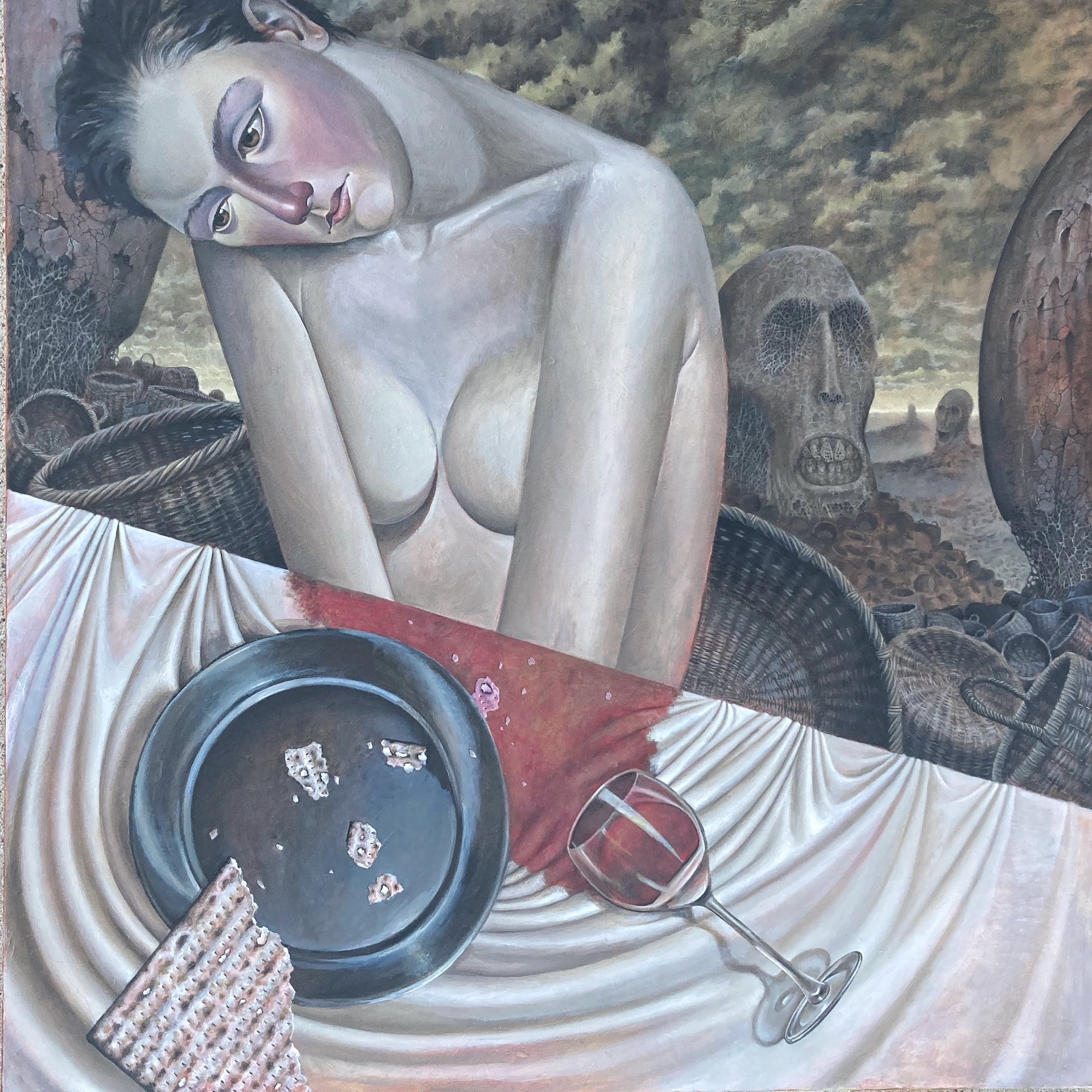
In The Presence of My Enemies, 2021, 36 x 36
Mythical Realism | Contemporary Religious Art | Eucharist, Lament, and Sacred Defiance
“In the Presence of My Enemies” by J. Richard Briggs is a stark and emotionally arresting oil painting that reinterprets the familiar words of Psalm 23 through a lens of surreal lament and sacred vulnerability. Set against an apocalyptic landscape littered with baskets, broken earth, and skeletal figures, a solitary, bare-breasted woman leans with quiet defiance over a table of bread, wine, and blood—a visual evocation of Eucharist, grief, and unflinching witness.
Her gaze is distant yet unwavering, tilted slightly as if bearing a weight unseen. The table before her is dressed in draped white linen and stained crimson—suggesting both ritual and violence, feast and sacrifice. A half-spilled glass of wine, a blackened dish with broken matzah, and the eerie presence of skull-like watchers in the background evoke a chilling reversal of sacred hospitality. This is not a safe table, but a table kept despite threat—a meditation on what it means to be nourished in the presence of fear, oppression, and death.
Briggs’ Mythical Realism and precise oil technique give the painting a timeless, icon-like stillness, while its subject matter burns with contemporary urgency. It invites reflection on bodily exposure, spiritual endurance, and the tension between intimacy and dread, layered with theological and liturgical echoes. It’s a table of remembrance, but also one of resistance.
Ideal for collectors of symbolic contemporary Christian art, surreal religious narratives, or those drawn to works engaging with suffering, ritual, and sacred resilience, In the Presence of My Enemies offers both a personal lament and a visual psalm of survival.
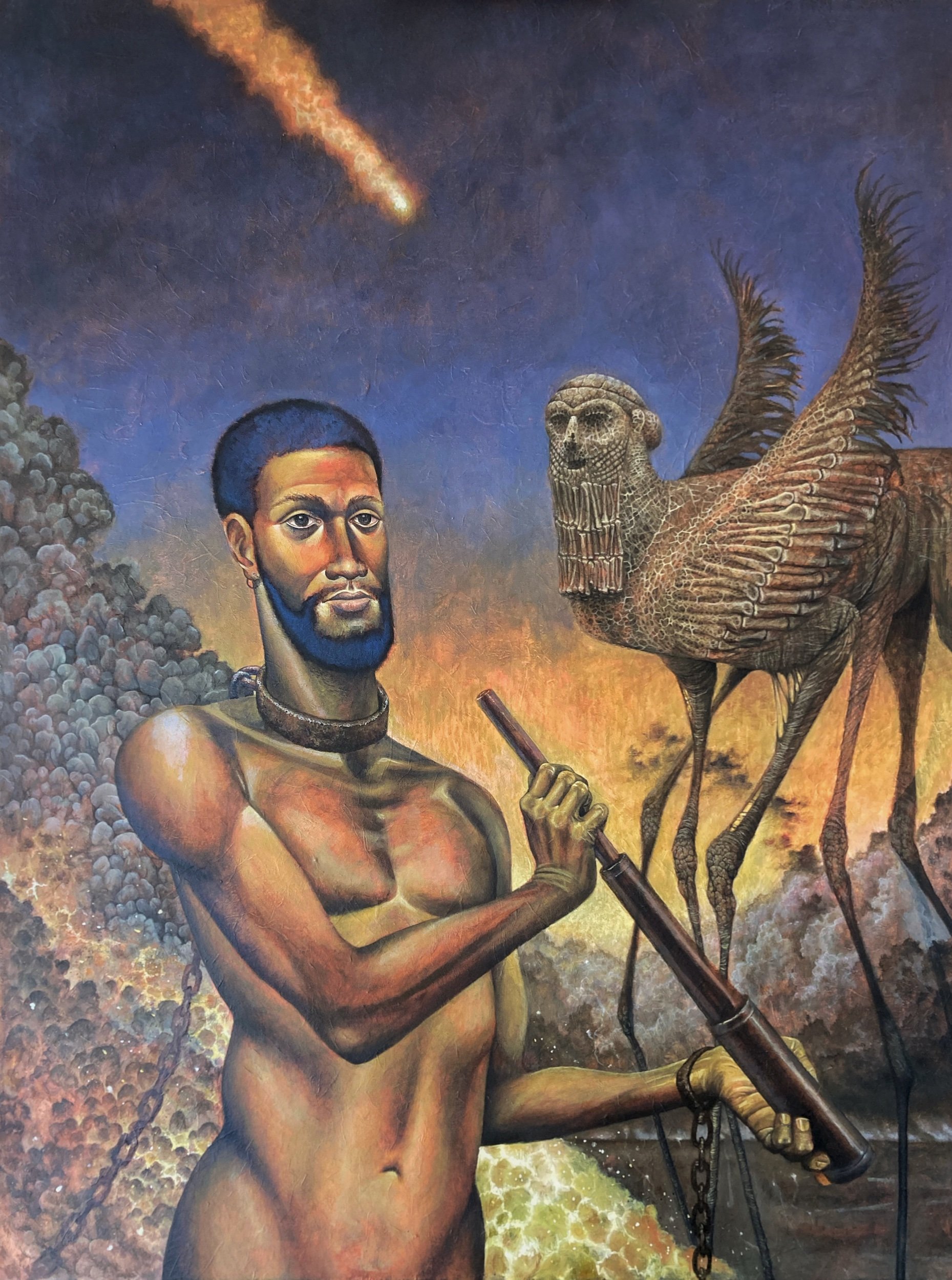
Daniel, 2021, 30x40
Mythical Realism | Contemporary Prophetic Art | Apocalyptic Imagery and Sacred Resistance
“Daniel, The Prophet” by J. Richard Briggs is a powerful and visually arresting oil painting that reimagines the biblical figure of Daniel not as a passive dream interpreter, but as a bold seer standing at the crossroads of empire, resistance, and revelation. Rendered in Briggs’ distinctive Mythical Realism, this work fuses ancient apocalyptic iconography with a modern sense of spiritual urgency and liberation.
Daniel appears nearly nude, bearing the marks of enslavement—chained, collared, and scarred, yet holding a telescope in one hand, a tool of both vision and hope. His gaze is forward, unflinching, defiant—not merely enduring exile, but reading the signs in the heavens. Behind him rises a winged, lion-bodied creature with the face of a man: a direct allusion to the visionary beasts of Daniel 7, symbols of empire, chaos, and cosmic power. Smoke and flame swirl beneath their feet, while a meteor descends through the night sky—portent, judgment, or promise, depending on the viewer’s posture.
Briggs paints this prophetic figure not in soft pastels or quiet contemplation, but with rich, burning hues and muscular conviction. This Daniel is not trapped in the past—he speaks to the present moment: to systems of oppression, to spiritual exile, to the longing for justice and apocalyptic unveiling.
This painting is a meditation on spiritual resistance, divine vision, and the role of the prophet as both seer and survivor. Through oil paint’s depth and texture, Briggs invites viewers into a sacred narrative that transcends time—where ancient prophecy becomes a mirror for our own fractured world.
Ideal for collectors of biblical visionary art, symbolic resistance imagery, and those drawn to works exploring justice, empire, and sacred truth, Daniel, The Prophet offers a haunting and hope-laced image of a man standing in fire and still looking to the stars.

Still Life in San Diego, 2023
Surreal Still Life | Symbolic Narrative Art | Love, Loss, and the Unseen Horizon
“Still Life in San Diego” by J. Richard Briggs is a deeply personal acrylic painting that reimagines the still life genre as a vessel of symbolic grief and fragile, unspoken hope. Painted in the wake of a romantic loss and a move away from San Diego, the work gathers fragments of memory, myth, and emotional residue into a surreal domestic altar—each object carefully chosen, each detail loaded with quiet ache.
At its center sits a Greek amphora, painted with the tragic intimacy of Achilles and Patroclus—a mythic love story etched into the surface of the vessel like a wound that refuses to fade. Nearby, a telescope rests on the table, pointed outward—not inward in reflection, but toward some unknown horizon the viewer cannot see. It becomes a symbol of longing, of unanswered questions, and of hope reaching beyond the ruins.
A turtle shell, cracked and empty, and a toppled clay pot lie beside it. The scene is surrounded by empty baskets, a symbolic echo of Briggs’ earlier Job painting, where baskets represented provision and fullness—now emptied by suffering. A toy dinosaur rests on the table’s edge like a forgotten remnant of childhood or a small nod to the absurd. Through the warped windowpane, the San Diego sky burns with surreal cloud forms and fading light, both beautiful and unsettling.
The title, Still Life in San Diego, offers a double entendre—evoking both the tradition of still life and the suspended life of a soul stilled by grief and relocation. And yet, within the sorrow, there is a whisper of insistence—the telescope doesn’t face the past, but out toward whatever comes next.
Painted in Briggs’ meticulous Mythical Realism, this work is ideal for collectors of symbolic surrealism, narrative-rich still life, and art that explores grief, memory, and spiritual persistence. It is a quiet, reverent witness to the ache of loss—and the small, stubborn reaching toward whatever healing might lie just beyond the frame.
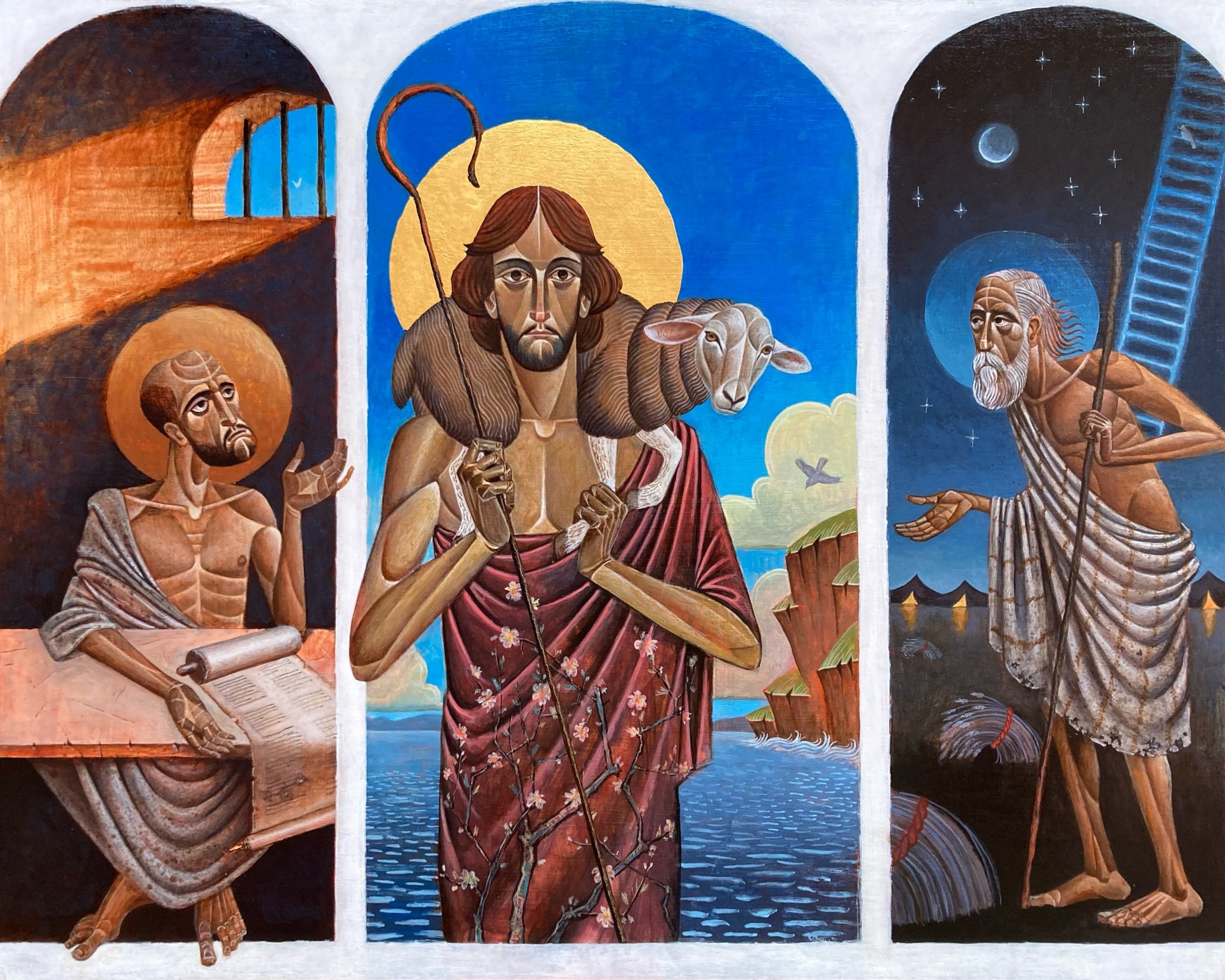
The Good Shepherd (with St. Evagrius and Jacob the Patriarch)

Forest Park Illuminated, 11x14, Acrylic on Paper



Afternoon on Misery Ridge, 24x30, Acrylic on Textured Panel







"Skull in Natural Light"
Mixed Media on Paper, 12"x9"

"A Final Exhale"
Mixed Media on paper, 9"x12"
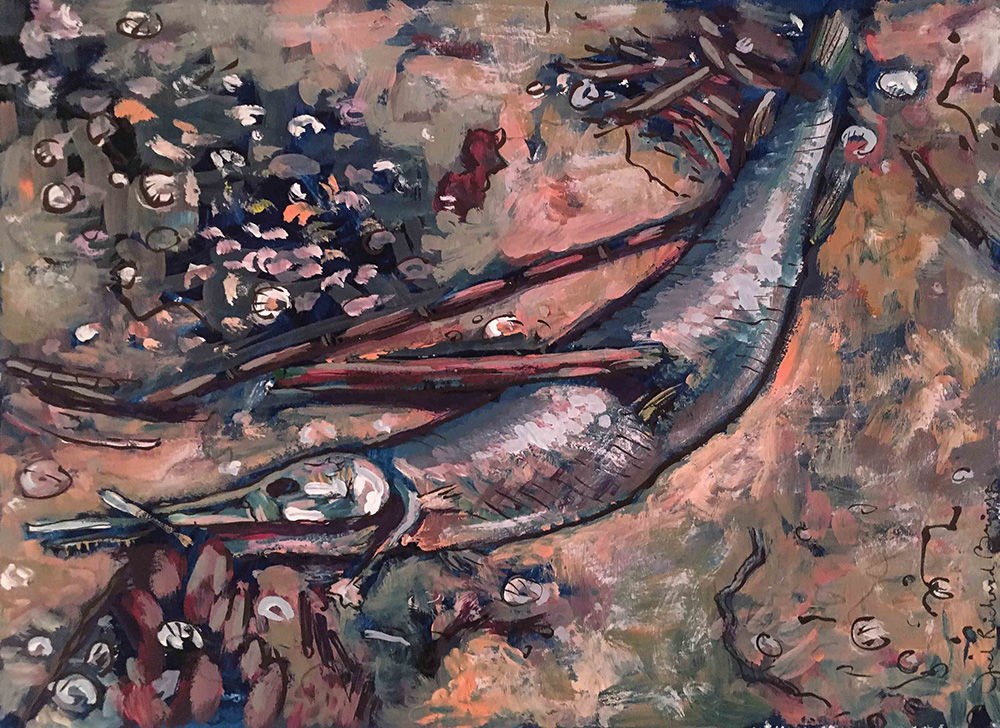
"On The Beach"
Gouache & Acrylic on paper, 12"x9"






"Almost Sunset in Ponta Vedra"
Gouache & Acrylic on Paper, 9"x12"

"Future Guacamole"
Acrylic on Paper
Fine Art
Explore the Art of J. Richard Briggs | Mythical Realism Gallery
Welcome to the official gallery of J. Richard Briggs, a Pacific Northwest fine artist known for his unique style of Mythical Realism. Here you’ll find a curated selection of original paintings that blend mythology, spirituality, faith, and the natural world into richly symbolic and emotionally resonant works of art.
Briggs’ paintings, primarily created with professional acrylics, oil paint, and gold leaf, merge the sacred traditions of Byzantine iconography and religious art with the human complexities of modern life—exploring themes of embodiment, anxiety, sexuality, and transcendence. Each piece is a portal into a world where the Divine meets the everyday, and where light, landscape, and human figures carry deeper meaning.
Whether you are a collector, curator, or lover of contemporary religious art, symbolic painting, or spiritually evocative landscape work, this gallery offers a glimpse into Briggs’ larger vision: a re-enchanted world where mystery, beauty, and sacredness still endure.
Browse the gallery below to view available works, recent collections, and commissioned pieces.
























Select Older Works















